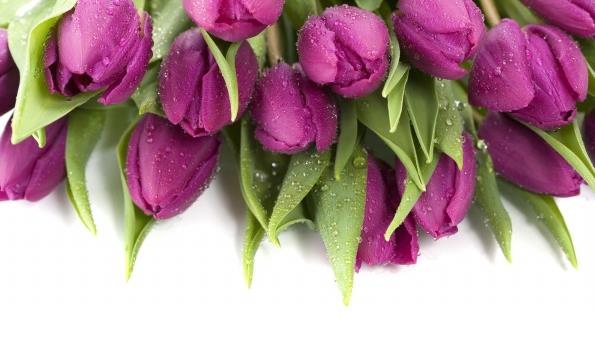What is the flower language of purple tulips? tulip cultivation methods
Why do tulips have fascinating charm? Perhaps the following recommended tulip bouquets can tell us the answer.
The charm of purple tulips: nobility and mystery
On behalf of bouquets-flowers / purple ☆ banned ☆ fans
Flower words: elegant purple tulips are infatuated and adored at first sight, just like I met you at the beginning!
The charm of red tulips: enthusiasm and happiness
Represents a bouquet of flowers / beloved
Hua Yu: from loving you, from feeling loving you, from remembering you from sleep, holding you, caring for you. You are the love of my life!
The charm of pink tulips: youth and lightness
Representative bouquet-flowers / romantic pink tulips
Flower words: there is a kind of love, romantic warmth; there is a kind of beauty, full of youth …... I only love you with a sincere heart!

Tulip, the national flower of the Netherlands, has always been popular for its mystery and nobility.
According to legend, there is a beautiful girl in Europe who is admired by three handsome knights at the same time. One gave her a crown, one gave her a sword, and another gave her gold. The young girl did not know how to choose, so she turned to the Flower God for help. The flower god turned her into a tulip, a crown into a bud, a sword into a leaf, and gold into a bulb, so he accepted the love of the three knights at the same time, and the tulip became the embodiment of love.
Tulip, elegant, refined, fresh and meaningful, is a noble and mysterious flower, which was specially planted for the royal aristocracy in the imperial garden of the Ottoman Empire as early as the 17th century. The flowers of tulips are colorful and varied, such as yellow flowers sprinkled with red dots on their petals, called "the blood of the king"; tripping red flowers with petals rolled up each other, called "lovers' kisses"; and a purple tulip called the "black widow".

Tulips imply elegance, wealth, ability and intelligence. The flower words of tulips are love, charity, fame, beauty, blessing, eternity, love and eternal blessing. The meaning of tulips with different colors is different from that of flowers. The most common tulips are yellow tulips, pink tulips, red tulips and purple tulips. The flower words and meanings of yellow tulips are elegance, treasure, wealth, love and friendship. The flower words and meanings of pink tulips are beauty, love, love, friendship, happiness, and red tulips are love advertising, declaration of love, joy, love. The flower words and moral of purple tulips are noble love and endless love.

Flower language-- Origin and Development
Flower language first originated in ancient Greece, at that time not only flowers, leaves, fruit trees have a certain meaning. It is recorded in Greek mythology that the god of love created roses when he was born, and roses have become synonymous with love since that time. The real flower language prevailed in the French royal period, when the aristocrats sorted out the folk materials about flowers, including the information of flower language, which was perfectly reflected in the garden architecture in the later stage of the court. Immediately popular in Britain and the United States, it was created by some writers, mainly used to publish gift books, especially for upper-class ladies to read at leisure at that time. The acceptance of flower language by the public was around the 19th century, when the social atmosphere was not very open, and it was embarrassing to express love in public, so the flowers given by lovers became the messengers of love. With the development of the times, flowers have become a social gift, and a more perfect flower language represents the intention of the giver.

The cultivation methods of tulips:
1. Soil: tulips require both water retention and air permeability, the salinity should not be too high, and the pH value should not be less than 6. The mixture of peat, mature soil and sand with 1 ∶ 1 ∶ 1 as cultivation medium has a better effect.
2. Sunlight: sufficient sunlight is necessary for the growth of tulips. Insufficient sunlight will cause poor plant growth, cause sprouting, plant weakening, lighter leaf color and shorter flowering period. But tulips on the pot after more than half a month, should be properly shaded, in order to facilitate the growth of new roots. In addition, during germination, the elongation of flower buds is inhibited by light. Shading can promote the elongation of flower buds and prevent the early vegetative growth from growing too fast. After emergence, light should be increased to promote plant jointing, form buds and promote coloring. After the buds are fully colored in the later stage, direct sunlight should be prevented and the flowering time should be prolonged.
3. Temperature: tulips prefer warm winters and cool summers, and the optimum temperature for growth is 9-13 ℃. Strong cold resistance, can withstand the low temperature of-35 ℃ in winter.

4. Watering: water should be watered thoroughly after planting, so that the soil and seed bulbs can be fully and closely combined to facilitate rooting, water should be properly controlled after budding, leaves can be gradually elongated, water can be sprayed on the leaf surface to increase air humidity, and adequate water supply should be ensured at bolting and budding stages to promote the full development of flowers and proper water control after flowering.
5, fertilization: tulips do not have high requirements for fertilizer, if the growth potential is weak, you can apply some nitrogen fertilizer. When the root system is well developed, 2 kg of calcium nitrate is applied every 100 square meters, spread in three times, each time at an interval of more than one week.
6. Insect pests: the pathogens of tulip diseases and insect pests can be carried by the seed ball or by the soil, which mostly occur in the environment of high temperature and high humidity. the main diseases are stem rot, soft rot, broken color disease, quenching disease, blind bud and so on. most of the pests are aphids. Adequate soil disinfection should be carried out before planting, virus-free bulbs should be selected as far as possible, diseased plants should be dug up and destroyed in time, and fungicides should be poured once or twice in the growth process of the greenhouse, the effect is better; good ventilation should be maintained to prevent high temperature and humidity; when aphids occur, 3% natural pyrethrum can be sprayed 800 times.
Grow up in vain. After emergence, light should be increased to promote plant jointing, form buds and promote coloring. After the buds are fully colored in the later stage, direct sunlight should be prevented and the flowering time should be prolonged.
3. Temperature: tulips prefer warm winters and cool summers, and the optimum temperature for growth is 9-13 ℃. Strong cold resistance, can withstand the low temperature of-35 ℃ in winter.

4. Watering: water should be watered thoroughly after planting, so that the soil and seed bulbs can be fully and closely combined to facilitate rooting, water should be properly controlled after budding, leaves can be gradually elongated, water can be sprayed on the leaf surface to increase air humidity, and adequate water supply should be ensured at bolting and budding stages to promote the full development of flowers and proper water control after flowering.
5, fertilization: tulips do not have high requirements for fertilizer, if the growth potential is weak, you can apply some nitrogen fertilizer. When the root system is well developed, 2 kg of calcium nitrate is applied every 100 square meters, spread in three times, each time at an interval of more than one week.
6. Insect pests: the pathogens of tulip diseases and insect pests can be carried by the seed ball or by the soil, which mostly occur in the environment of high temperature and high humidity. the main diseases are stem rot, soft rot, broken color disease, quenching disease, blind bud and so on. most of the pests are aphids. Adequate soil disinfection should be carried out before planting, virus-free bulbs should be selected as far as possible, diseased plants should be dug up and destroyed in time, and fungicides should be poured once or twice in the growth process of the greenhouse, the effect is better; good ventilation should be maintained to prevent high temperature and humidity; when aphids occur, 3% natural pyrethrum can be sprayed 800 times.
Related
- Wuhan Hospital Iron Tree Blooming Result Was Instantly Frightened by the Gardener Master
- Which variety of camellia is the most fragrant and best? Which one do you like best?
- What is the small blue coat, the breeding methods and matters needing attention of the succulent plant
- Dormancy time and maintenance management of succulent plants during dormancy
- Minas succulent how to raise, Minas succulent plant pictures
- What are the varieties of winter succulent plants
- How to raise succulent plants in twelve rolls? let's take a look at some experience of breeding twelve rolls.
- Attention should be paid to water control for succulent plants during dormant period (winter and summer)
- Watering experience of twelve rolls of succulent plants
- Techniques for fertilizing succulent plants. An article will let you know how to fertilize succulent plants.



